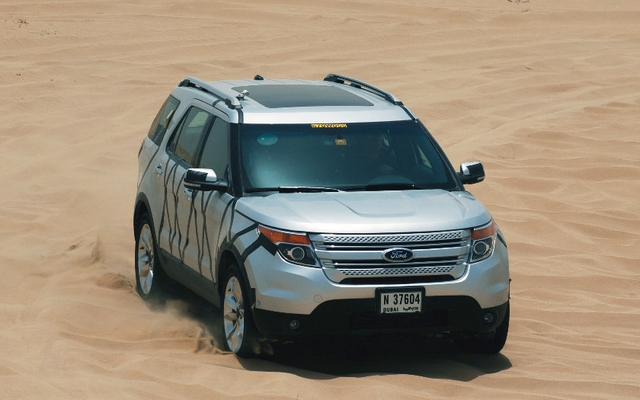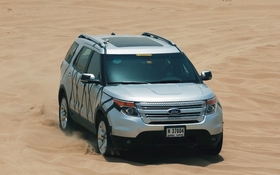2011 Ford Explorer: A reflection of our era
These days, vehicles have become so sophisticated and efficient that it’s hard to say everything in a single article. As for me, since I had the opportunity to try the vehicle on the Ford circuit in Romeo, Michigan, I’ll focus my observations on its off-road handling and Curve Control system.
But before getting to all that, I will mention that the new Explorer features a monocoque body, replacing the previous version’s body on frame chassis. What’s more, the new vehicle comes with front-wheel drive, while the old Explorer was a very traditional rear-wheel drive. Ford is also very pleased to announce that the vehicle is slightly bigger than before, and yet it is lighter and more fuel efficient.
In terms of mechanics, Ford chose the 3.5-litre V6 paired with a six-speed automatic gearbox, which brings down fuel consumption by more than 20%. A little later this year, they will offer a 2.4-litre Ecoboost engine, available with front-wheel drive only. The vehicle we tested was equipped with the V6.
Let’s go play in the sand!
Like any self-respecting test track, Ford’s features a multitude of different terrains and road types. There are inclines on which you can test engine capacity for uphill climbs, as well as off-road areas where you can check out all-terrain vehicle stability on downhills. Areas covered in soft, deep sand allow you to test the efficiency of your four-wheel drive. The engineers presenting the new 2011 model proudly explained the new four-wheel drive system, which they call "Terrain Management System".
This intelligent system adapts the four-wheel drive to the terrain type. This mechanism was primarily developed by British automaker Land Rover-Range Rover, and it has now been adopted by a number of manufacturers. You shouldn’t be surprised to find Ford among them, as it owned the British brand for several years and its engineers participated in the development of this mechanism.
While the way it works is quite exceptional, it remains disconcertingly easy to use. This four-wheel drive system is controlled by a large button on the console. You simply select the pictogram that represents current conditions – you can choose from Snow, Sand, Mud and uneven terrain modes, as well as a system hill descent.
During our test drive, we had some fun on terrain with fairly loose sand. First, we set the dial to "Sand" then launched into the intimidating test area. Despite all our efforts to sink into the sand, the electronically managed 4WD proved to be surprisingly effective in all senses. I spun the steering wheel like mad and tried to accelerate, but the vehicle just moved forward without any resistance. It’s incredibly easy to use and very effective. I’ve long been a fan of entirely mechanical all-wheel drive systems, but these more modern and effective technologies are starting to win me over.
Obviously, when you’re driving on the highway, you just turn the dial back to Normal and that’s that. As there was no snow in Michigan in October, I’ll have to wait for a winter test drive to try out the Snow mode.
Hill descent
To give us the chance to compare the new system offered on the new Explorer, the public relations people at Ford chose the Toyota 4Runner. You might say they skewed the competition a little since the Toyota system, despite being effective, seriously lacks refinement and requires the use of at least two controls to start the hill control system.
In contrast, on the Explorer it’s just a matter of pushing a single button.
I have to admit that this exercise seemed a little daunting. Accompanied by an engineer, I headed to the top of a promontory. Perched on the edge of solid ground, all we could see in front of us was the beautiful blue October sky. I even asked my passenger if there really was a slope ahead of us. With an amused smile, he reassured me that there really was land – but it was at 65 degrees at least! You really have to be confident in the mechanics of a vehicle to plunge into a descent like this one.
The first test was carried out in the Toyota, and everything went quite well, though we had the impression that things could take a turn for the worse at any time. With the Explorer, we just pressed the button then aimed the vehicle downhill, and it proceeded with better control and a much gentler ride. I would really have liked to try the same exercise in a Jeep Grand Cherokee to see if there would be as much difference. But in comparative tests like these, they don’t always choose the most comparable competitors.
Curve Control
During the presentation of the new Explorer, we also had the chance to take the vehicle on the road sections of the test track. I should mention that the Ford test centre in Romeo is known for its demanding roads. This time, they wanted to show us the vehicle’s stability and control on bumpy surfaces. I’ll come back to this part of the test drive a little later. But before I do, I want to explain that the Explorer also comes equipped with a unique system called "Curve Control". It automatically slows the vehicle when the management system determines that you are taking a corner too quickly, thereby increasing your risk of losing control. When that happens, the vehicle’s speed is automatically reduced as a way of ensuring safe driving. I tried it – timidly, I must confess – and it was very effective. What’s more, my colleague Marc Lachapelle also gave it a go, and he was much bolder about it. The mechanism worked very well for him, too.
Another pro added to the list is the superbly calibrated suspension, which can handle bumpy roads without any major ups or downs. Our comparison vehicle was the Jeep Grand Cherokee, and its handling was markedly less stable.
About those engines…
I will finish by questioning the engine choices. And I’m not alone in doing so. In absolute terms, the V6 engine is justified. They wanted to limit, as much as possible, development costs, and this engine had proven itself and was available. And it wasn’t a bad engine either. However, during the comparison test drives at this presentation event, I was given the chance to drive a Jeep Grand Cherokee on the same hill as the Explorer. The Jeep’s V6 Pentastar does a better job managing torque, and it proved to have a little more pep on uphill climbs.
One of Ford’s goals was to reduce fuel consumption as much as possible, and the 2.0-litre four-cylinder Ecoboost engine promised excellent fuel economy. However, it basically turns the Explorer into a big urban station wagon with limited towing capacity and no 4WD.
Despite this weak point, the engineers assigned to developing this model did one heck of a good job. And I would definitely hate myself if I forgot to mention that dashboard strikes a good balance between traditional controls and the touch and voice activated systems. And if you like the company’s trademark grille, you’re bound to love the new Explorer.







